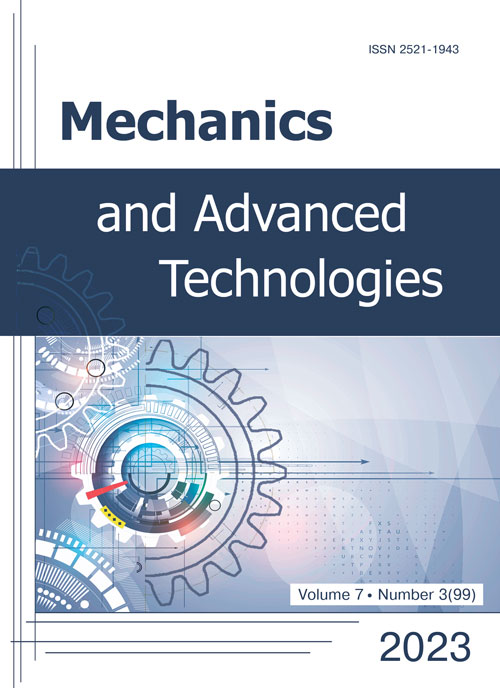The influence of the degree of throttling on the dynamic parameters of a two-way drive with vacuum gripping devices
DOI:
https://doi.org/10.20535/2521-1943.2023.7.3.290105Keywords:
actuators with vacuum grippers, the effect of throttling on transient processes in the driveAbstract
An assessment of the current state of research on transient processes in pneumatic actuators is presented. The advantages and disadvantages of pneumatic drives with vacuum gripping devices and their connection with practical design tasks are shown. It has been established that the calculation of parameters and the design of high-speed, typical pneumatic actuators and actuators with vacuum grippers differ significantly. The expediency of using vacuum gripping devices in manipulation drives is shown. It was established that, unlike pneumatic cylinders of mechanical gripping devices, for which the final phase of the actuation cycle is important, in which the piston at the end of the stroke is already stationary, but the pressure in the working cavity increases and, accordingly, the force on the rod increases, for actuators with vacuum gripping devices, this phase is not is taken into account. The choice of a mathematical model and a methodology for calculating the transient processes of double-acting pneumatic actuators is substantiated. The model involves recording the equation of motion of the cylinder piston, supplemented by equations describing pressure changes in the working and exhaust cavities of the cylinder, followed by computer simulation. As part of the mathematical model, a study of transient processes was carried out, therefore, all simulation results are shown in the time interval limited by the period of piston movement (ie, preparatory and final periods were not considered). The effect of the effective areas of the input and output pneumolines of the pneumocylinder on dynamic processes in the actuator was studied. It was established that the change in the diameter of the inlet opening and, accordingly, the area of the inlet opening of the working or exhaust cavity leads to a change in the flow rate and capacity factor of the communication lines, is characterized by a change in the kinetic energy of the output link, limits its working speed and ensures the smoothness of the movement of the output link of the drive.
References
- V. Y. Kostiuk and A. P. Havrysh, Promyshlennye roboty: konstruyrovanye upravlenie, ekspluatatsyii, Kyiv: Vyshcha shkola, 1985.
- A. A. Shaparyn, A. D. Chudakov and B. V. Shandrov, Avtomatyzatsia proizvodstva (metalloobrabotka): uchebnik dlia na-chalnoho professyonalnoho obrazovanyia, Moscow: Akademyia, 2004, 255 p.
- Osnovy avtomatyzatsii mashynobudivnoho vyrobnytstva: pidruchnyk dlia vuziv, Yu. M. Solomentseva Ed., 3-th izd., Ster, Moscow: Vyshcha shkola, 2001, 312 p.
- N. P. Kosov, A. N. Ysaev and A. H. Skhyrladze, Tekhnolohycheskaia osnastka: voprosy y otvety, Moscow: Mashynostroenye, 2005, 303 p.
- E. V. Pashkov, Yu. A. Osynskyi and A. A. Chetverkyn, Elektropnevmoavtomatika v proyzvodstvennykh protsessakh, E.V. Pashkova Ed., 2-e izd., pererab. i dop., Sevastopol: Yzd-vo SevNTU, 2003, 496 p.
- Pnevmaticheskie sredstva avtomatyzatsyy: Kataloh 1998/1999, Esslynhen (FRH): Festo AG CO. 2000.
- D. N. Popov, Dynamyka y rehulyrovanye hydro- y pnevmosystem, Moscow: Mashynostroenye, 2016, doi: 10.38050/013001052016414
- K. L. Navrotskyi, Teoryia y proektyrovanye hydro-y pnevmopryvodov, Moscow: Mashynostroenye, 1991.
- E. V.Herts and H. V. Kreinyn, Raschet pnevmopryvodov. Spravochnoe posobye, Moscow: Mashynostroenye, 1975.
- V. V. Sedach, Yssledovanye dynamyky tsyklovoho pnevmopryvoda avtomatycheskoho oborudovanyia, Vestnyk Nats. tekhn. un-ta "KhPI": sb. nauch. tr. Temat. vyp.: Tekhnolohyy v mashynostroenyy, No. 54, pp. 119–124, 2010.
- V. M. Stasiuk, “Dynamyka podkrytycheskoho rezhyma pnevmomekhanycheskykh pryvodov mashyn udarnoho deistvyia,” Lutskyi natsyonalnyi tekhnycheskyi unyversytet “Perspektyvni tekhnolohii ta prylady”, No. 15, pp. 94–98, 2019.
- N. A. Zaitseva, “Vlyianye parametrov sylovykh pnevmopryvodov promyshlennykh robotov na perekhodnye protsessy v nykh,” Vestnyk MYYTa, Vol. 10, pp. 67–73, 2004.
- A. S. Donskoi, Modelyrovanye perekhodnykh protsessov v pnevmatycheskykh systemakh, SPb.: SPHUTD, 1998.
- A. S. Donskoi, Obobshchennye matematycheskye modely elementov pnevmosystem, SPb.: SPHUTD, 2001.
- Hydropryvody y hydropnevmoavtomatyka Stankov, V. A. Fedortsa Ed., Kyiv: Vyshcha shk. Holovnoe yzd-vo, 1987.
- Dynamyka pnevmatycheskykh system mashyn, E. V. Herts Ed., Moscow: Mashynostroenye, 1985.
Downloads
Published
How to Cite
Issue
Section
License
Copyright (c) 2023 Сергій Вікторович Носко, Олександр Сергійович Галецький, Дмитро Вікторович Костюк

This work is licensed under a Creative Commons Attribution 4.0 International License.
Authors who publish with this journal agree to the following terms:
- Authors retain copyright and grant the journal right of first publication with the work simultaneously licensed under CC BY 4.0 that allows others to share the work with an acknowledgement of the work's authorship and initial publication in this journal.
- Authors are able to enter into separate, additional contractual arrangements for the non-exclusive distribution of the journal's published version of the work (e.g., post it to an institutional repository or publish it in a book), with an acknowledgement of its initial publication in this journal.
- Authors are permitted and encouraged to post their work online (e.g., in institutional repositories or on their website) prior to and during the submission process, as it can lead to productive exchanges, as well as earlier and greater citation of published work











